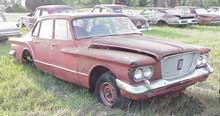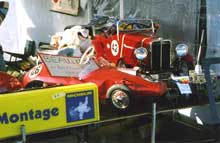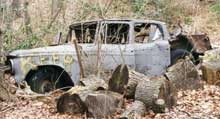Prince Valiant
On October 29,1959, Chrysler Corporation entered the compact car sweepstakes with Valiant, intended as a corporate competitor to Ford's Falcon and Chevy's Corvair. The Big Three automakers thus served notice that American Motors and Studebaker would not have this new market segment to themselves.
In contrast to the rather bland styling of Falcon and Corvair, and AMC and Studebaker's use of old tooling, Chrysler offered a distinctive car styled by Virgil Exner, reminiscent of his 1950s Ghia-built d'Elegance in both front and rear aspects. Powered by the new slant six engine, Valiant used Chrysler's hallmark pushbutton control transmission or, if a manual gearbox was fitted, a nifty floor shift. An industry first was the use of an alternator for better low-speed charging of the battery. In addition to the four-door sedan, a four-door wagon was offered. Bodies, as nearly all 1960 Mopars, were unitary and dipped for rust protection.
For 1961, Valiant got a new grille and a Plymouth badge - the car had been just "Valiant," though sold by Plymouth dealers. 1961 also brought a smart two-door hardtop. Sales, though, were less than half of Falcon's and somewhat behind Corvair. With the addition of intermediate-size cars by Ford and Chevy in 1962, Valiant fell even farther behind. When Exner styling was replaced for 1963 with the rectangular runes of Elwood Engel, however, sales improved, more so in 1964 and '65, by which time the distinctive "fishbowl-tail" Barracuda had been added as Plymouth's ponycar contender.
The 'Cuda took on a personality of its own in 1967, by which time a convertible and notchback hardtop coupe had joined the catalog. By 1969, Barracuda was a muscle car, available with engines as large as 383 cubic inches (from 1970, a 440 was available). The turning point in Valiant's life, though was the introduction of the semi-fastback Duster coupe in 1970, which promptly captured 80 percent of production. The Duster remained the best-selling Valiant nearly to the end of production in 1976, when it was succeeded by the fairly forgetable Volare. Valiant had spawned an Australian offshoot, powered by the small block 273-cubic-inch V8, which had become a US option in 1964. Dodge dealers, too, wanted a Valiant, so a Lancer version was spun off for them in 1961 and '62.
The homogenized post-1962 Valiants sold better than the early Exner-designed models, proving, perhaps, that blander is better. For a distinctive collector car, though, you could be well served by a 1960-62 Valiant, if you can find one.
The 1960 Valiant that tops this page is in the eclectic Virtual Salvage section of Sunman Classic Ford Supply in Seminole, Oklahoma. If you need a project car or parts, of FoMoCo or other make, contact them or check their inventory on line.



Web-Feature.jpg)
